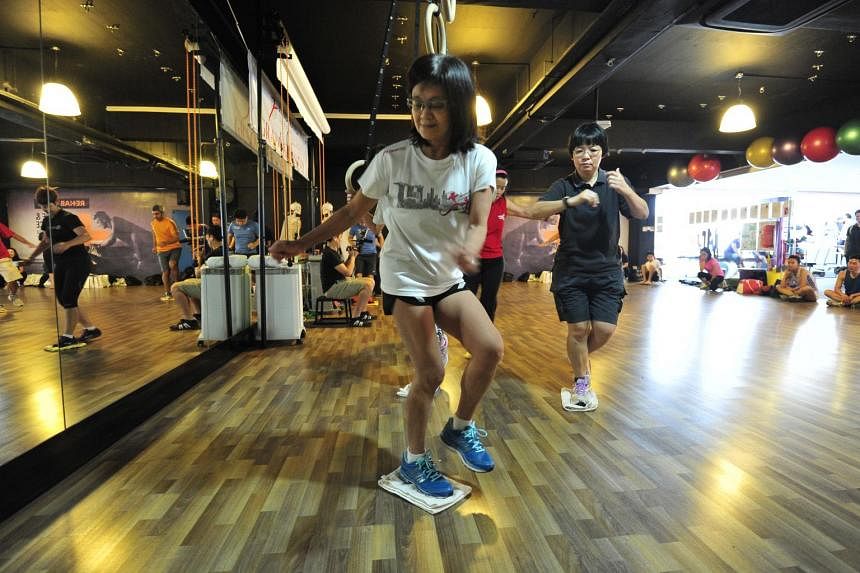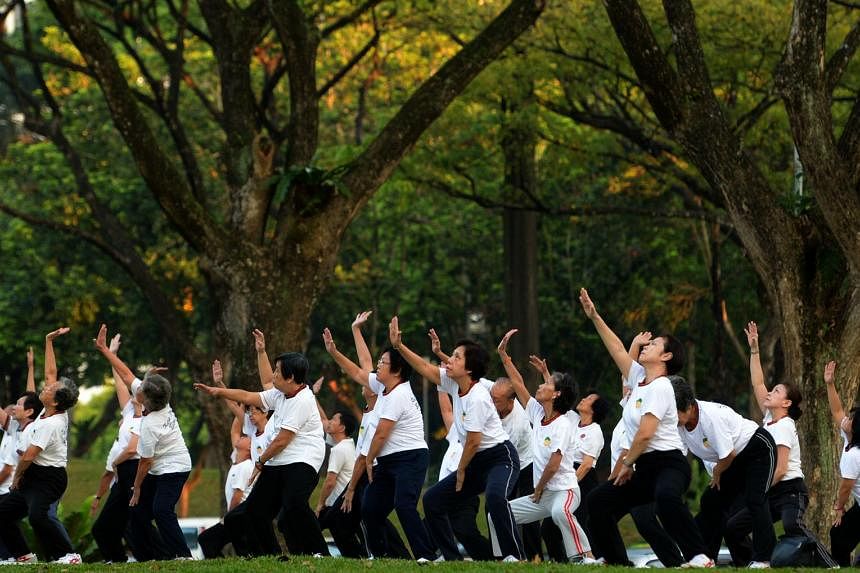Here are the top 10 fitness trends according to the American College of Sports Medicine's worldwide survey for this year:
1 BODYWEIGHT TRAINING
What it is:As the name suggests, one's body weight is used as the source of resistance. Little or no equipment is used, making it convenient and affordable.
Why bother: Performed correctly as part of an all-round health and fitness programme, it improves muscle strength and coordination, helping to improve one's quality of life and prevent injuries, said Dr Roger Tian, a consultant sports physician at Singapore Sports Medicine Centre and the Changi Sports Medicine Centre.
Take care: Exercises done in a position where the head is lower than the body greatly increase blood pressure in the head and should be avoided by those with hypertension, diabetes, eye disorders or people who have had a stroke.
Be aware of great stress on the shoulders and knees, said Dr Tian.
One may face a higher risk of shoulder injuries, such as rotator cuff tendinosis and tears, as well as trauma to the cartilage and menisci - the areas of cartilage tissue that act as shock absorbers - in the knees.
2 HIGH-INTENSITY INTERVAL TRAINING (Hiit)
What it is: Short bursts of activity followed by a short period of rest or recovery. These workouts are usually performed in 30 minutes or less.
Why bother: It can be an adjunct for those seeking to improve their sports performance, or who want to optimise whatever scant time they have for exercise, said Dr Tian.
Take care: As one's heart rate can easily reach 90 per cent or more during Hiit, those with underlying medical conditions or who are unfit should avoid it. Participants aged 35 years and above, or those with a family history of heart disease and metabolic disorders, should first seek clearance from a medical professional, he added.
3 EDUCATED AND EXPERIENCED FITNESS PROFESSIONALS
What is it: Demand for such fitness professionals continues to climb.
Why bother: Having a sound understanding of what, why and how an individual responds to certain exercises will enable the trainer to set realistic training goals for you and to help you achieve those goals through an individualised exercise programme, said Ms Tong Yuyan, an exercise physiologist and trainer at Singapore Sports Medicine Centre.
Take care: Fitness professionals should always keep abreast of the latest research and fitness trends to provide better advice to their clients. Most importantly, they should be able to demonstrate and guide their clients on proper exercise techniques to minimise the risk of injuries, said Ms Tong.
4 STRENGTH TRAINING
What it is: An essential part of a complete exercise programme for men and women of all physical activity levels.
Why bother: It prepares the body for the rigours of sport. It not only improves performance, but can also reduce the risk of injury, said Dr Tian.
Take care: Avoid holding your breath and straining yourself when lifting weights, he advised.
When done excessively and ignorantly, it can result in neck and shoulder pain or injury.
Flexibility training, such as stretching or yoga, should be incorporated into the routine, as well as regular cardiovascular exercise, to prevent one from becoming stiff and clumsy, said Mr Nelson Chong, founder of the Functional Training Institute.
5 PERSONAL TRAINING
What it is: Education, training and proper credentials for personal trainers are increasingly important to the health and fitness facilities that employ them.
Why bother: Trainers can empower clients to take charge of their lives, said Mr Chong.
Take care: Do not hire one randomly. Nowadays, trainers are expected to have at least a recognised certification - for instance, by the National Strength and Conditioning Association or the American Council on Exercise. Some may hold a degree related to exercise or sports science, said Ms Tong.
6 EXERCISE AND WEIGHT LOSS
What it is: Providers of weight-loss programmes are increasingly incorporating regular exercise and calorie restrictions for their clients.
Why bother: Losing weight and keeping it off requires one to expend more calories than one consumes. Exercise is an important part of the equation.
Regular exercise can also help one to maintain muscle mass during a weight-loss programme, said Dr Tian.
Take care: Those who are grossly overweight or who have joint problems should avoid high-impact exercise such as running, skipping and jumping, he said.
7 YOGA
What it is: Based on ancient tradition, yoga utilises a series of specific postures practised for health and relaxation. There are many schools.
Why bother: It involves some functional-training components and it trains the mind, body and spirit. You can practise it any time and anywhere, said Mr Chong.
Take care: Many yoga asanas or positions involve the knee being placed in a flexed position, putting a great load on the knee's menisci and cartilage. Asanas that involve the hyperextension or flexion of the spine can damage the facet joints and discs in the lumbar spine, said Dr Tian.
8 FITNESS PROGRAMMES FOR OLDER ADULTS
What it is: Age-appropriate and safe fitness programmes to keep older adults healthy and active.
Why bother: Regular physical activity is an important part of active ageing, as it improves one's quality of life. It also reduces the risk of falls and slows the rate of loss of both muscle and bone mass, which occurs during ageing, said Dr Tian.
Functional training may be useful here, as it can help the elderly regain qualities that make daily living easier, such as cardiovascular endurance, strength and flexibility, said Mr Chong.
Take care: Proper footwear is all the more important for the elderly. If they wear the wrong shoes, they may trip and fall. Some older adults like to wear loose-fitting shoes, but shoes should have a snug fit.
Before embarking on a new exercise programme, elderly folk should undergo a proper movement screening - to determine their flexibility, for instance. This will help the trainer customise the programme for them or advise them on what exercises to go for, said Mr Chong.
9 FUNCTIONAL FITNESS
What it is: Using strength training to improve one's balance and ease of daily living. Closely related to special fitness programmes for older adults.
Why bother: It is aimed at making one stronger and more able to perform activities in daily life, said Ms Tong.
Take care: A certain level of fitness is required. Before performing explosive exercises - such as sprinting, jumping, twisting and lunging - that mimic everyday movements, build up your strength or address any muscle imbalance to ensure the workout's effectiveness. This can also reduce the risk of injury, she added.
10 GROUP PERSONAL TRAINING
What it is: Training two or three people at a time makes economic sense for the trainer and the clients.
Why bother: You get mutual encouragement, support and other benefits, which improve compliance with an exercise programme, said Dr Tian.
Take care: Group members may have different fitness and exercise levels. This makes it risky for the weaker members too who may try to match the performance of their "stronger" peers, said Dr Tian.
Some may also have specific musculoskeletal or medical conditions that require an exercise or technique to be modified, which may not be possible in big groups, he added.
Besides, there is no "one-size-fits-all" regimen, said Ms Tong. As training goals, fitness status and skills differ from person to person, there is a need to apply some individualisation to group training for it to be effective. Before you join a group, speak to the group trainer about your goals and health or fitness concerns, she suggested.




